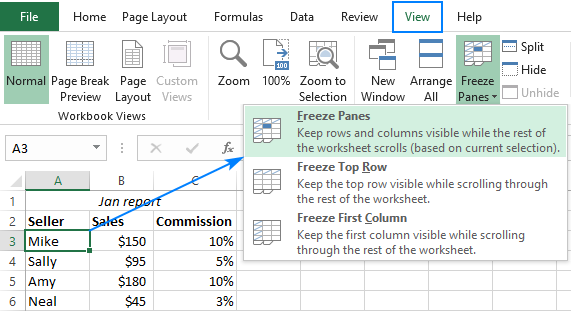

The first VISIBLE column in the Excel window is frozen.A single column is frozen at the left side of the worksheet.If you select the Freeze First Column command, it does not automatically freeze Column A on the worksheet. To see any rows that are above the frozen row, use the Unfreeze command.If the frozen row has other rows above it, you can't scroll up to see those rows.The frozen row stays in place if you scroll up or down on the worksheet.For example, row 7 is frozen in the screen shot below, because rows 1-6 were not visible, when the Freeze panes option Freeze Top Row was applied.First row that is VISIBLE in the Excel window is frozen.A single row is frozen at the top of the worksheet.Any cell on the worksheet can be selected.If you select the Freeze Top Row command, it does not automatically freeze Row 1 on the worksheet. The 3 Freeze Pane options work differently, and each option is explained below. To see the Freeze Pane options, click the arrow on the Freeze Panes button.On the Microsoft Excel Ribbon, click the View tab.Here are the quick steps for setting up freeze panes on your spreadsheets: This makes it easier to work with a large Excel worksheet, or Excel tables.

With a few rows and columns locked in place, you can scroll the rest of the spreadsheet, while keeping your row labels at the left, and column headings in place, at the top of the screen. If you want to scroll down the worksheet, and lock the heading rows in place, so they're always visible, you can use one of the Excel Freeze Panes commands. More Tutorials Lock Rows and Columns in Place


 0 kommentar(er)
0 kommentar(er)
